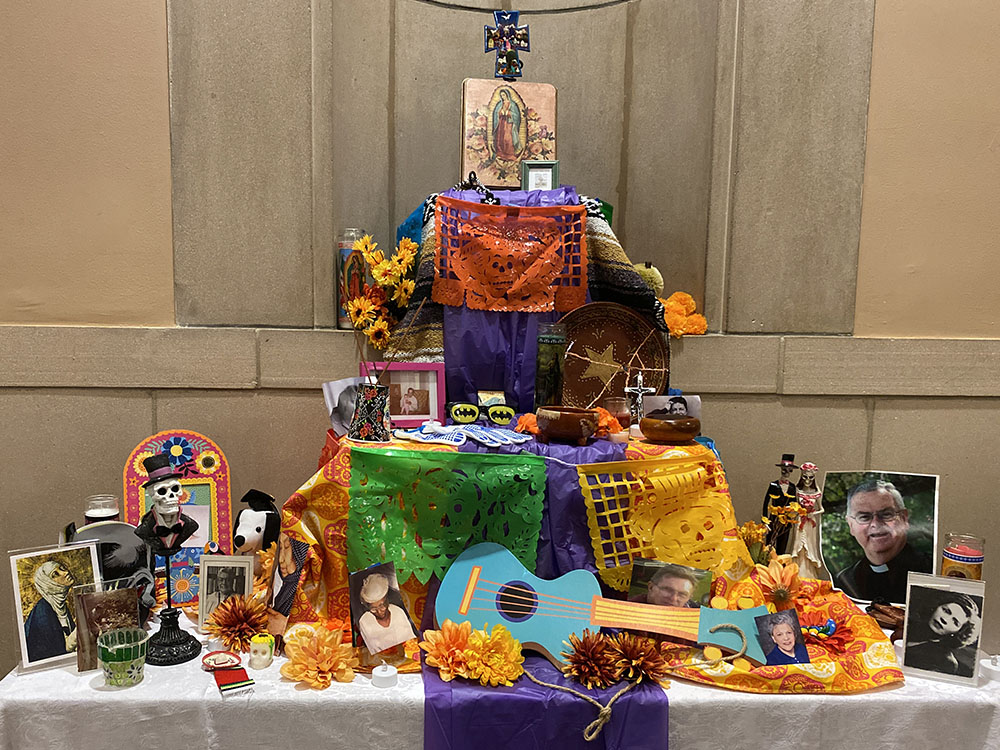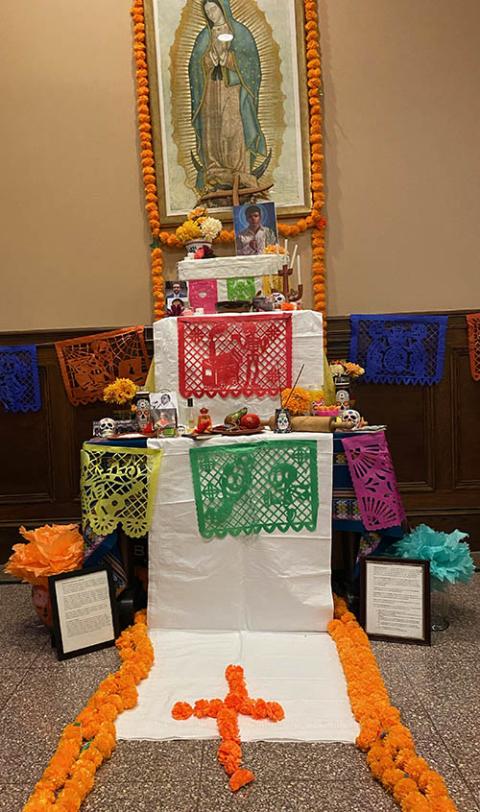
A Day of the Dead altar at Boston College, November 2023 (Ana Gonzalez)
October is one of my favorite months. Growing up in El Paso, Texas, October brought a well-deserved respite from the hellish temperatures of the summer. With the cooler temperatures, some seasonal delights made a welcome return. (Here's looking at you, champurrado, chocolatito caliente and calabaza en tacha).
While the ghosts, goblins, and festive ambiance of Halloween preoccupied the Anglo population, we were placing our orders at Bowie Bakery and getting ready our Altares for the Día de Muertos. Bowie Bakery, or "La Bowie" was my go-to place to get pan de muerto, the traditional bread of the season.
Several community organizations hosted Día de los Muertos events, inviting us to remember our beloved dead. La Mujer Obrera ("The Working Woman"), a community center and amazing co-op, had a folkloric showcase of altares de muertos. This was one of my personal highlights! Each altar paid special homage to the deceased with a reverent, spiritual and artistic approach.
The members of my community participated and shared the altar experience, which fortunately also included delicious pan de muerto and champurrado.

A Day of the Dead altar at Boston College, November 2023 (Ana Gonzalez)
Through the festivities of Día de Muertos, mentors shared with me the importance of celebrating life and remembering our deceased loved ones. Each altar de muertos honors and rejoices in the lives of the ancestors and our loved ones gone before us. It's a way to remember that each of us stands on the shoulders of generations that came before us ... that each of us living today is the legacy and dream of our ancestors.
The tradition of Día de los Muertos also highlights for us that we are people of the Resurrection, and death is not the end of our story.
The Día de los Muertos tradition is the result of a cultural compromise between Mexican Indigenous traditions and European Catholic practices.
In addition to photographs of our ancestors, some of the mandatory elements of the altar de muertos include the sugar skull, a symbol that death is not bland and bitter. For those of us who believe in the resurrection, death is sweet and colorful.
Candles are a symbol of Christ, the light of the world, a guide for all souls to follow. Similarly, the marigold petals, or cempasúchil with the firefly orange petals, symbolize the light of the sun and create a pathway for the souls of our ancestors to follow.
The container of water symbolizes the baptismal waters and our call to be a people of God. Incense and salt symbolize purification, while papel picado, the colorful perforated tissue paper, often with designs, represents air and the fragility of life.
The creation of the altar takes into consideration a deep awareness of the four elements and our interconnectedness with creation and Earth.
I moved away from El Paso 11 years ago, yet I am fortunate enough to pay homage to my ancestors in the communities where I have lived since. It is an honor for me to share this tradition with my sisters and community members, but one aspect of the celebration is a cause for disappointment. Like so many religious or spiritual days, my beautiful Mexican tradition is falling prey to consumerism.
Advertisement
Yes, I know I am on the verge of sounding like a grumpy señora but the altar de muertos is not part of Halloween. The sugar skulls are not fun decorations that mix with the spooky and scary. I roll my eyes when I enter stores and see the effort to devalue the rich symbols of the altar de muertos. I am even more annoyed at the people who dress up as a skull out of ignorance.
These symbols of my heritage and culture are part of a reverent remembrance grounded in my Catholic faith. Through the Día de Muertos and the traditional altares, I honor and pray for my ancestors and honor, as a Catholic, the lives of those who came before me. I am a mestiza, and the altar de muertos is also a way to honor my Indigenous and Catholic ancestors.
It might be bold, but I invite you to consider fighting consumerism and joining me in placing your own altar de muertos this November. As you begin, remember that your own altar is intended to remember your beloved deceased ancestors, sisters and mentors. We want to offer this remembrance because their lives have meaning.
We can also take this opportunity to remember all the victims of war, senseless violence, and racism. We remember these victims because we must never commit those atrocities again. We remember them so that we can unite our voices in a prayer to end injustice so that the generations that come after us can have a prosperous future.
With its color, folklore, prayerfulness and rich symbolism, the altar de muertos is a tangible offer of the promise of resurrection for those who have died, and for the living. More than a memorial to the dead, it is a sign of hope for all of us.





